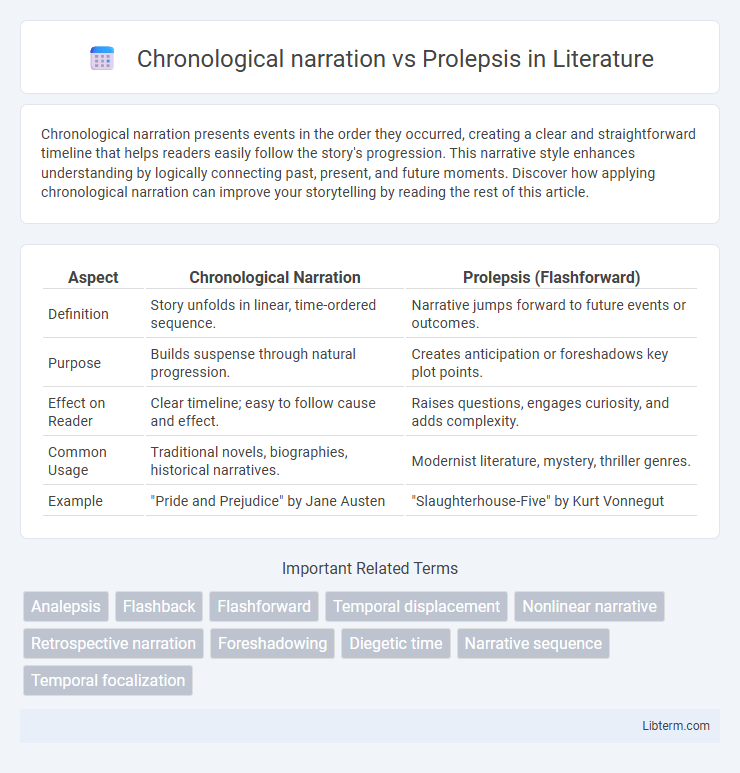Chronological narration presents events in the order they occurred, creating a clear and straightforward timeline that helps readers easily follow the story's progression. This narrative style enhances understanding by logically connecting past, present, and future moments. Discover how applying chronological narration can improve your storytelling by reading the rest of this article.
Table of Comparison
| Aspect | Chronological Narration | Prolepsis (Flashforward) |
|---|---|---|
| Definition | Story unfolds in linear, time-ordered sequence. | Narrative jumps forward to future events or outcomes. |
| Purpose | Builds suspense through natural progression. | Creates anticipation or foreshadows key plot points. |
| Effect on Reader | Clear timeline; easy to follow cause and effect. | Raises questions, engages curiosity, and adds complexity. |
| Common Usage | Traditional novels, biographies, historical narratives. | Modernist literature, mystery, thriller genres. |
| Example | "Pride and Prejudice" by Jane Austen | "Slaughterhouse-Five" by Kurt Vonnegut |
Introduction to Chronological Narration and Prolepsis
Chronological narration presents events in the order they occur, allowing readers to follow a timeline naturally and understand cause-and-effect relationships clearly. Prolepsis, or flashforward, interrupts this sequence by revealing future events, creating suspense and emphasizing key plot points. Understanding the distinction between these narrative techniques enhances comprehension of storytelling structures and their impact on tension and pacing.
Defining Chronological Narration
Chronological narration presents events in the order they occur, maintaining a linear progression from beginning to end. This storytelling technique aligns with the natural flow of time, enhancing clarity and audience comprehension. By unfolding the plot sequentially, it contrasts with prolepsis, which involves jumping forward to future events or flash-forwards.
Understanding Prolepsis in Storytelling
Prolepsis in storytelling refers to a narrative technique where future events are revealed before their chronological occurrence, creating suspense or foreshadowing outcomes. Unlike chronological narration, which unfolds events in sequential order, prolepsis disrupts the timeline to enhance thematic depth and character development. Mastery of prolepsis allows writers to strategically manipulate reader expectations and enrich the overall narrative experience.
Key Differences Between Chronological Narration and Prolepsis
Chronological narration presents events in the order they occur, maintaining a linear timeline that enhances clarity and straightforward comprehension. Prolepsis, or flash-forward, disrupts this sequence by revealing future events ahead of their chronological position, creating suspense or foreshadowing. The key difference lies in temporal structure: chronological narration follows a cause-and-effect flow, while prolepsis introduces anticipatory insights that alter narrative pacing and reader expectations.
Narrative Flow: Linearity vs. Disruption
Chronological narration maintains a linear narrative flow by presenting events in sequential order, enhancing clarity and temporal coherence for the reader. Prolepsis disrupts this linearity by incorporating future events or flash-forwards, creating narrative tension and foreshadowing that enrich the storytelling experience. The contrast between these techniques influences pacing and audience engagement, with chronological narration emphasizing straightforward progression and prolepsis introducing complexity and anticipation.
Effects on Reader Engagement
Chronological narration provides a clear, linear progression that helps readers easily follow the story's development, fostering sustained engagement through natural curiosity about what happens next. Prolepsis, or flash-forward, creates suspense and anticipatory tension by revealing future events, prompting readers to actively piece together narrative clues and remain intrigued. Using prolepsis can enhance emotional impact by contrasting present moments with foreshadowed outcomes, deepening the reader's connection to characters and plot.
Notable Examples in Literature and Film
Chronological narration structures stories in a linear timeline, as seen in Harper Lee's "To Kill a Mockingbird," where events unfold in the order experienced by the protagonist Scout Finch. Prolepsis, or flash-forward, disrupts this sequence by revealing future events, prominently used in Homer's "The Odyssey" and Christopher Nolan's film "Memento," where past and future intermingle to deepen narrative complexity. These techniques shape audience perception by controlling information flow, with chronological narration fostering suspense through gradual discovery, while prolepsis creates dramatic irony and foreshadowing.
Advantages and Limitations of Each Technique
Chronological narration offers clear, linear storytelling that enhances audience comprehension and maintains natural tension progression but can limit narrative complexity and suspense. Prolepsis, or flash-forward, creates intrigue and foreshadows future events, enriching thematic depth and emotional impact; however, it risks confusing readers and disrupting narrative flow. Each technique balances clarity and engagement differently, influencing pacing and the audience's interpretive experience.
Choosing the Right Narrative Structure
Choosing the right narrative structure impacts how readers engage with the story, with chronological narration offering a straightforward, time-ordered progression that builds suspense through natural cause and effect. Prolepsis, or flash-forward, introduces future events early, creating anticipation and thematic depth by revealing outcomes before their causes. Writers must balance clarity and intrigue by selecting a structure that suits the story's pacing, complexity, and emotional impact, ensuring the narrative flow enhances the reader's understanding and investment.
Conclusion: Enhancing Stories through Narrative Techniques
Chronological narration provides a clear, linear progression of events that helps audiences easily follow the storyline, while prolepsis introduces future events early to create suspense and deepen engagement. Combining these narrative techniques enhances storytelling by balancing predictability with surprise, enriching the emotional and cognitive experience for readers or viewers. Effective use of chronology and prolepsis ultimately strengthens thematic development and accentuates the story's impact.
Chronological narration Infographic

 libterm.com
libterm.com